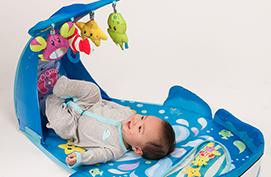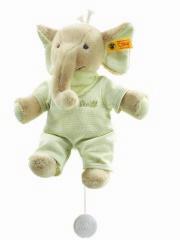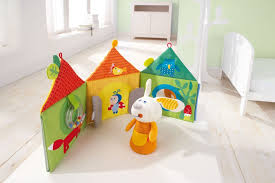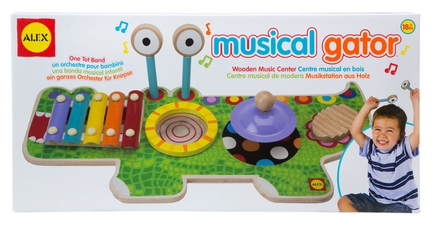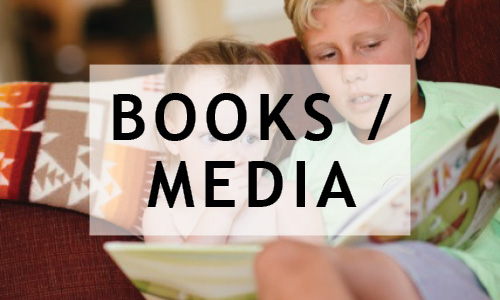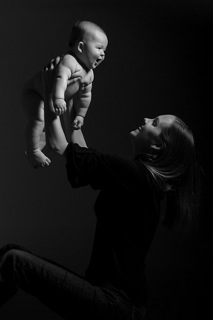 When baby arrives, it’s time to play. Since newborn babies prefer a variety of shapes, curves, angles and contrasts in light and dark, your face is his first favorite toy! He reacts as you talk to him and smile, watching your mouth, eyes and face move, casting shadows and changing expressions.
When baby arrives, it’s time to play. Since newborn babies prefer a variety of shapes, curves, angles and contrasts in light and dark, your face is his first favorite toy! He reacts as you talk to him and smile, watching your mouth, eyes and face move, casting shadows and changing expressions.
But by the time your baby reaches three months, he can see more clearly, focus on an object and is interested in a toy. You’re still a favorite but now it’s time to pick great toys that will enhance language. Certain features in a toy will invite more language, giving you more to talk about as you play with your baby.
1. Find a Friendly Face: Choose toys that have a friendly face. A rooster, a caterpillar or even an apple can all have a face, ready to engage in your baby in conversation with you. Babies are naturally attracted to faces and actually talk more to a face, especially one with lots of expression. Take on the voice for your bug or pony and talk to your baby, describing actions like eating, sitting, playing, or galloping while moving your toy. Blocks and stacking rings are great toys for building that can be animated when they have a face on them. Look for toys with a face.
2. Feels Good: Describe contrasting textures to provide your baby with lots of exciting vocabulary like crinkly, smooth, bumpy, soft, hard or fuzzy. Talk about the puppy’s shiny, smooth paws and fuzzy, squishy tummy, as your baby is exploring the toy. Look for toys that have lots of contrasts in texture—some soft, hard, slippery, fuzzy, bumpy or smooth surfaces. The more contrasts your toy has, the more you have to describe and talk about with your baby. Feeding babies descriptions with rich vocabulary builds their understanding or words (receptive language) and prepares them to say their their first words (expressive language) around one year of age and build up to 50+ words by the age of 2, combining 2 words together to make their first mini sentences.
3. Sounds Alive: Many baby toys make a sound—a rattle, a jingle, or a squeak. Some even make the sound for the specific animal like a bark for a dog or moo for a cow. Squeeze your little dog to bark or shake your elephant to rattle, pause and watch your baby’s response. Talking about the sounds you’ve heard and repeating them yourself adds interest to your baby’s play and promotes listening skills.
4. Colorful Contrasts: Since newborns focus on the boldest patterns and see only some color, toys with bold patterns of black and white are of greatest interest to them. But, by the time a baby is three months old, he can make nearly all the color distinctions so bring on the color! While a toy with many contrasting colors is exciting to look at, it also provides lots of opportunity to describe the different colors, by the caregiver. Don’t forget a board book with bright colors on a white background serves as an interesting “toy” to look at also. Hold the book up so your baby can see it as well as your face as you read the simple text, or prop it up for a more interesting tummy time.
5. Bring on the Action: Look for flexibility in a toy—one where you and your baby can engage in lots of action to describe. Moving parts like doors to open, peek-a-boo windows, containers to put things in, and openings to push through all provide opportunities to talk about objects in, out, through, and opening and shutting.
6. Peek in a Mirror: At about 6 months babies react to their own image in a mirror and start to babble and giggle at themselves. Make sure the mirror is large enough so your baby can see herself in the toy. Follow your baby’s lead and let her start the conversation, with you joining in to add to the dialogue.
As a speech and language expert and grandmother of 7, here are some of my favorite PAL Award picks for great play and learning with your baby:
Walk-Along-Snail by Hape
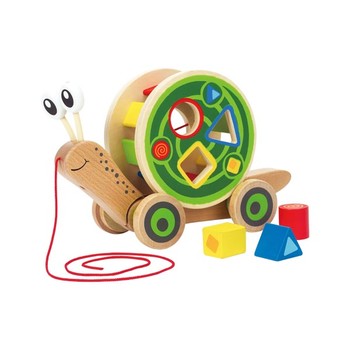 This goofy snail with the wiggly, buggy eyes is a happy companion as he tags along, rotating his shell of colored blocks. Flexibility in a toy leads to open-ended play, as children grow and can remove the snail’s shell for some shape sorting practice.
This goofy snail with the wiggly, buggy eyes is a happy companion as he tags along, rotating his shell of colored blocks. Flexibility in a toy leads to open-ended play, as children grow and can remove the snail’s shell for some shape sorting practice.
Wonder Whale Kicks and Giggles Activity Gym by Infantino
Parents appreciate Infantino’s baby products designed for multiple learning stages, keeping equipment to the minimum as little adjustments can take a baby from over-head discovery to lying on her back watching and reaching for the sea animals or turned around to kick the whale’s tail, jiggling the toys and chatting back to them.
Trampili Elephant Music Box by Steiff
Elephants are a hot item in the nursery these days and this little one invites a hug or coo with his stitched on smile and eyes. Pull his cord to soothe your baby to sleep and know that he is listening to differences in sounds and building listening skills preparing for speech.
Magic Forest Friends by HABA
Magic Forest Friends decorate six interactive sides of a reversible house complete with a bunny to reside inside or out. Describing little activities associated with each animal as well as sensory options both tactile and auditory, make this playbook an enriching language learning experience.
Musical Gator by ALEX Toys
Kids can experiment with the beat and different sounds of the instruments, building listening and discrimination skills. Since kids learn to imitate gestures before sounds and words, this Musical Gator is perfect for playing a little game of follow the leader while building skills essential for language learning! Tap two times on the drum and hand the mallet to your toddler, waiting for his response. Then follow his lead to imitate what he bangs next, engaging in your own learning game.
